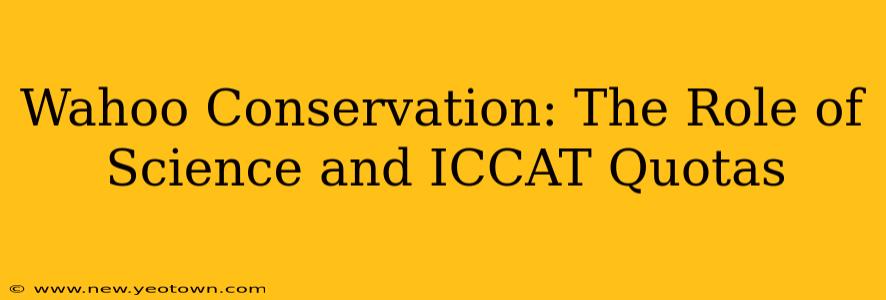The wahoo ( Acanthocybium solandri ), a sleek, powerful pelagic fish, is prized for its delicious meat and thrilling sport fishing qualities. However, this prized game fish faces increasing pressure from overfishing, necessitating robust conservation efforts. Understanding the role of science and the International Commission for the Conservation of Atlantic Tunas (ICCAT) quotas is crucial to ensuring the future of this magnificent species.
What is ICCAT and how does it regulate wahoo fishing?
The International Commission for the Conservation of Atlantic Tunas (ICCAT) is an intergovernmental organization responsible for the conservation and management of tuna and tuna-like species in the Atlantic Ocean and adjacent seas. This includes the wahoo. ICCAT sets catch limits (quotas) for various species, including wahoo, based on scientific advice. These quotas aim to prevent overfishing and allow fish stocks to replenish. The effectiveness of these quotas relies heavily on accurate stock assessments and the cooperation of member countries in adhering to the regulations. Enforcement remains a significant challenge, however, with illegal, unreported, and unregulated (IUU) fishing posing a persistent threat.
How is science used to inform wahoo conservation?
Scientific research plays a critical role in informing wahoo conservation strategies. Scientists use various methods to assess wahoo populations, including:
- Stock assessments: These involve analyzing data on catch rates, fish size, and age to estimate the abundance and reproductive capacity of wahoo populations.
- Tagging studies: Attaching tags to wahoo allows researchers to track their movements, migration patterns, and growth rates, providing valuable insights into their life history and ecology.
- Genetic analysis: Genetic studies can help determine population structure and connectivity, informing management decisions about separate stocks.
- Fisheries-independent surveys: These surveys, conducted independently of commercial fishing, provide unbiased estimates of wahoo abundance and distribution.
This data is essential for setting scientifically sound catch limits and designing effective management strategies. The accuracy and reliability of this data directly influence the effectiveness of ICCAT's conservation measures.
What are the main threats to wahoo populations?
Overfishing is the primary threat to wahoo populations. This includes both targeted fishing for wahoo and bycatch (incidental capture) in other fisheries. Other threats include:
- Habitat degradation: Pollution and climate change can impact wahoo habitat and prey availability.
- Gear selectivity: Some fishing gear is less selective, resulting in higher bycatch rates of wahoo.
Addressing these threats requires a multifaceted approach, including stricter enforcement of regulations, improved fishing gear selectivity, and habitat protection measures.
Are ICCAT quotas effective in protecting wahoo?
The effectiveness of ICCAT quotas in protecting wahoo is a complex issue. While the quotas aim to prevent overfishing, their success depends on several factors:
- Accuracy of stock assessments: Inaccurate assessments can lead to quotas that are either too high or too low.
- Compliance with regulations: Effective enforcement is crucial to ensure that fishing fleets adhere to the established quotas. This often proves challenging, particularly in addressing IUU fishing.
- Adaptability to changing conditions: ICCAT quotas must be regularly reviewed and adjusted based on new scientific information and changing environmental conditions.
While ICCAT quotas provide a framework for wahoo conservation, their effectiveness is constantly evaluated and refined through ongoing scientific research and international cooperation.
What can be done to improve wahoo conservation?
Improving wahoo conservation requires a collaborative effort among scientists, policymakers, and fishers. Key actions include:
- Improving data collection and stock assessments: Investing in research to improve the accuracy and reliability of stock assessments is paramount.
- Strengthening enforcement of ICCAT regulations: Combating IUU fishing through improved monitoring, control, and surveillance measures is essential.
- Promoting sustainable fishing practices: Encouraging the adoption of selective fishing gear and responsible fishing practices can minimize bycatch and reduce fishing pressure.
- Raising public awareness: Educating consumers and anglers about the importance of wahoo conservation can drive demand for sustainably sourced wahoo.
The future of the wahoo depends on a commitment to science-based management and international cooperation. By addressing the challenges of overfishing and habitat degradation, we can ensure the continued survival of this magnificent species for generations to come.

